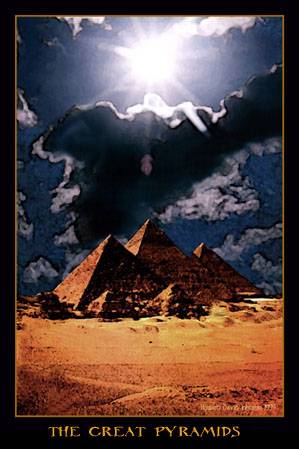The Seven Wonders Of Ancient Egypt
302mb | xvid@791kbps | 640*480 | 29.976 fps | 45min | 128 kbps JS mp3 | English
Documentary
Lasting Monuments of the Egyptians
Ancient Wonders
Over 3,000 years ago the ancient Egyptians created some of the finest monuments the world has ever seen. The Great Pyramid, the largest stone building on Earth. The Valley of the Kings, underground tombs holding the treasure of the pharaohs.
7. The Valley of the Kings
The kings of ancient Egypt were no mere mortals, they were Gods incarnate, and the ancient Egyptians cared more for the burial of their kings than any other nation that has existed. 3,500 years ago they began to build the most revered cemetery on Earth. The Valley of the Kings is the most magnificent burial ground in the world. Sixty two tombs, cut deep into the rock, overflowing with the treasures of ancient Egypt. Pharaohs like Tutankhamun and Ramesses the Great were laid to rest here. The oldest tomb in the valley belonged to King Tutmos 1st and dates back to the 16th century B.C. Most of the tombs in the valley are unfinished, the work being cut short by the king's death. However, the tomb of Seti 1st is virtually complete. It was unearthed by Giovanni Battista Belzoni in 1817 who was fortunate enough to chance upon the longest and deepest of all the tombs.
Hatshepsut's Temple
Queen Hatshepsut's Temple
6. Queen Hatshepsut's Temple
Built over the hillside from the Valley of the Kings, the Temple of Queen Hatshepsut is the most impressive monument of western Thebes. Hatshepsut's futuristic temple is packed with revolutionary features, a fitting memory to one of Egypt's most innovative pharaohs. The eldest daughter of Tutmos I, her young stepson became pharaoh, Tutmos III. Worried that the boy might lose control, she appointed herself co-regent and later King. Unlike Cleopatra and Nefertiti, little is known about Hatshepsut. She set out to finish what her husband had started, under her control it would take fifteen years to complete the greatest architectural achievement of her dynasty.
Karnak Temples
Karnak Temple Complex
5. The Karnak Temple Complex
When Thebes became the religious centre of Egypt, the Karnak temple became the seat of Amun, the state God. Karnak was soon home to over 600 priests. It's buildings spread south and west towards the Nile. At the centre, is a hyper-style hall with a forest of columns, some of which reach 70ft high. It also contains Hatshepsut's obelisk which at 96ft is the largest surviving obelisk standing in Egypt. Weighing 323 tons, it is carved from a single piece of granite from 400 miles away at Aswan. Building on a massive scale never daunted the Kings of Ancient Egypt, each one set out to surpass the last.
Ramesses' Temple
Temple of Ramesses
4. The Temple of Ramesses II at Abu Simbel
Built to advertise Ramesses' ultimate power, the Temple at Abu Simbel would be the finest rock-cut temple in the world. Gangs of masons were set to work on the facade to transform a cliff-face into two enormous statues of the pharaoh. Carved out of the living rock they would be 69ft high. It is thought that the location was chosen partly for the suitability of the rock face and also because it was close to the Nile and would be seen, from miles away, by anyone entering Egypt from the south.
Monastery
St. Catherine's Monastery
3. Mount Sinai
Some wonders are not man-made, they are natural shrines and spiritual landmarks. At 7,000ft Mount Sinai, or Gebel Moosa, is the highest mountain in southern Sinai and one of the most spiritual places on Earth. According to biblical accounts, it was here that Moses, amidst a violent storm, scrambled to the top of the mountain where, it is said, the heavens opened and God gave Moses the 10 commandments written on 2 stone tablets. To mark the site where Moses received the commandments, a Greek Orthodox monastery was built over 1500 years later and dedicated to the Christian martyr St. Catherine. The monastery is the oldest on Earth, and has been the centre for pilgrimages for over 15 centuries. It is also one of the finest examples of Byzantine architecture. Since Moses' time the monks have carved 4,000 steps of repentance up the mountainside allowing pilgrims a path to the top.
2. The Sphinx
The largest free-standing stone sculpture in the world. An enigma and very mysterious as no-one is certain who it depicts, or who made it. Hald human, half animal, the Sphinx has long been considered the strangest icon on the planet. At 60m long and 20m high, it guards the Giza plateau beside Egypt's two largest pyramids. For centuries, the Sphinx has been seen as the key to life. Pharaohs have worshipped at it's feet, conquerors have knelt down before it. The Sphinx has been subjected to every test but remains an enigma. Why was it built, why are there tunnels inside it, which king does it represent, what power does the Sphinx hold? In ancient Egyptian art, the idea of fusing animal with human was nothing new, but this was the first time a human head was sculpted onto a lion's body. In Egypt there was only one erson who could be portrayed in this way, the Pharaoh himself.
Pyramid of Giza
The Great Pyramid
1. The Great Pyramid of Giza
Is the oldest wonder of the world and has been standing for 4,500 years. It's the greatest tomb ever constructed and remains the largest stone building on Earth. It was built for the Pharaoh Khufu in 2,560 B.C. and from that time to this, the great pyramid has remained an icon of world architecture. Khufu set out to create a pyramid that was perfect. It is aligned with the compass and the base is level. It covers an area of 13 acres and is level to within one inch. It is constructed from 2,300,000 stone blocks, some of which way 5 tons and took 22 years to complete.
http://rapidshare.com/files/22878576/7.anct.eegpt.part2.rar
http://rapidshare.com/files/22875308/7.anct.eegpt.part1.rar
http://rapidshare.com/files/22870246/7.anct.eegpt.part3.rar
or
http://rapidshare.com/files/22641868/7.anc.egpt.part3.rar
http://rapidshare.com/files/22640214/7.anc.egpt.part2.rar
http://rapidshare.com/files/22640189/7.anc.egpt.part1.rar



